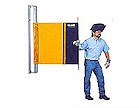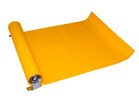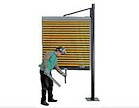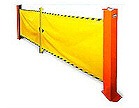
OVERVIEW
Protecting your operators from the dangers of moving machinery is imperative to maintaining a safe working environment. That is why Akon provides automation work cells with these unique retractable machine guarding fences. They simply unroll to provide full protection from sparks and other flying debris. This unique design allows for the smallest possible footprint and allows material to be moved into and out of the work cells quickly and efficiently.
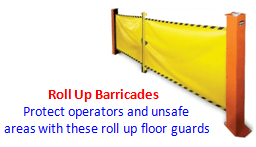

Operating the Retractable Machine Fence
With this unique design, the operator simply walks the retractable machine guarding fence from one end of the work cell to the opposite end of the work cell. Unlike traditional welding screens, the roll out machine guarding fence will not require the worker to man-handle it to move it out of the way for the forklift to enter the work cell or for an overhead crane to gain access.
The retractable machine guarding fence can be as long as 20 feet in length and as tall as 4 feet in height. The footprint of the roller is only 9 inches wide when it is completely retracted. This extremely small footprint lends itself well to applications where space is at a premium, such as a welding cell with a robotic arm along an assembly line.
Key Specifications
The roller uses tension to maintain a taunt guarding surface when the roller is completely unrolled. This is not much different than the roller shade you would find in a house window. To operate, the associate simply grabs onto the handle which is located as part of the roller assembly, and walks it to the opposite end of the work cell. He then latches the roller assembly onto the hooks which will hold the machine guarding fence until he unlatches it and walks it back to the home position.
The roller is constructed from a heavy-duty 3 inch aluminum tube. The fabric is constructed from a heavy-duty vinyl which will resist radiant heat, ultraviolet light, sparks, and flying debris. This vinyl is a 16 ounce thick fire resistant and oil resistant material that is CFM approved for temperatures of 3° to 165° Fahrenheit continuous.

